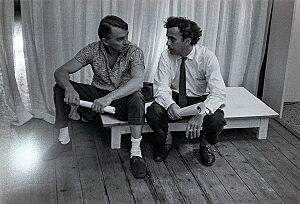Museum of Modern Art Australia facts for kids
The Museum of Modern Art Australia (MOMAA) was an important art museum in Melbourne, Australia. It was started in 1958 by an art supporter named John Reed. The museum showed many exciting and new artworks from Australia and around the world during the late 1950s and early 1960s. MOMAA operated until 1966 and officially closed in 1981.
How It Started
In July 1938, John Reed and his wife, Sunday Reed, helped create the Contemporary Art Society (CAS). Their goal was to support and show modern art in Australia, which was different from the traditional art popular at the time.
Through the CAS, John and Sunday met many artists. They became very good friends with and supported Sidney Nolan, even letting him live at their home, 'Heide,' from 1941 to 1947. Other artists they helped included Albert Tucker, Joy Hester, Arthur Boyd, and John Perceval.
John Reed stopped working as a lawyer in 1943. By the end of World War II, he and Sunday were the main supporters of modern art in Australia. They even gave money regularly to several artists. Their home, 'Heide,' became a famous meeting place for artists and writers, known as the Heide Circle. This group grew to include artists like Charles Blackman and Mirka Mora.
On June 1, 1956, the Reeds opened their first exhibition after taking over the CAS space. It featured works by "Melbourne Woman Painters," including Joy Hester and Mirka Mora. After this, they showed Sidney Nolan's famous Ned Kelly series, which had also been shown in New York.
The Museum Building
In mid-1958, with help from friends and supporters like Georges Mora, the Reeds turned the CAS gallery into the Museum of Modern Art Australia (MOMAA). John Reed became its director. The museum was designed to be like the famous Museum of Modern Art (MoMA) in New York.
The museum was located on the top floor of an old bluestone warehouse in Tavistock Place, Melbourne. In 1956, an architect named Peter Burns helped change the space into an art gallery. The main gallery was a long, rectangular room. It had dark grey carpet on the floor and a dark blue ceiling. The walls were painted white, and wire mesh was used to hang the artworks. The museum was lit by bright fluorescent lights and spotlights.
The first exhibition at MOMAA showed artworks that the Reeds' artist friends had given to the museum. In 1962, the museum moved to a different location, a vacant floor in the Ball & Welch department store on Flinders Street. The museum worked hard to promote modern Australian artists. For example, in 1958, a painting by Charles Blackman called Dream was sent to a museum in Paris.
Exhibitions and Artworks
The museum's collection started with 163 artworks that John and Sunday Reed had collected over 30 years. These artworks included different styles like figurative (showing real things), abstract (shapes and colors), expressionist (showing feelings), and realist (showing things as they are). Many important exhibitions were held at MOMAA.
Some of the notable exhibitions included:
- 1958: Modern Australian Art, showing paintings and drawings from a Melbourne collection.
- 1958: An exhibition of 94 paintings and 11 sculptures by Danila Vassilieff.
- 1958, May–June: An exhibition by Mirka Mora.
- 1958, August: An exhibition by Ian Fairweather.
- 1958, September: John Perceval's Angels exhibition.
- 1960, October–November: An exhibition by Albert Tucker.
- 1961: The Formative Years, 1940 – 1945, featuring works by Arthur Boyd, Sidney Nolan, and John Perceval.
- 1961: Laurence Hope: Antarctic Paintings, showing artworks inspired by Antarctica.
- 1962, February: The Annandale Imitation Realists show by Sydney Pop Art artists Mike Brown, Colin Lanceley, and Ross Crothall.
- 1963, September: A special exhibition of drawings by Joy Hester.
- 1964: The Sidney Nolan Ned Kelly paintings 1946–47 were shown again.
- 1964, May: A large exhibition of paintings by Arthur Boyd from 1936 to 1962.
- 1964: Photovision 1964, an exhibition of photographs by various artists.
- 1965, August: New generation 1965, showcasing works by young painters from Sydney and Melbourne.
Museum Closure
The museum moved to the Ball & Welch department store in 1964 (or 1962, according to some records) hoping to host bigger shows. However, the museum faced many money problems that they could not solve. In April 1965, John Reed resigned, and the Museum of Modern Art Australia closed its doors a year later.
The Reeds continued their art activities at their home, Heide. New, modern buildings were finished there in 1967, becoming known as Heide II. In 1980, just before John and Sunday Reed passed away, they sold Heide to the Victorian Government. This allowed it to become a public art museum and park, now known as the Heide Museum of Modern Art.
In 1981, the remaining members of the Museum of Modern Art Australia officially closed the museum. Its collection of artworks was given to the National Gallery of Victoria. The agreement stated that these artworks should be shown at the Heide Museum as a tribute to John and Sunday Reed, who were so important in creating the collection. This led to an exhibition called Forgotten treasures – works from the original Museum of Modern Art and Design Collection in 1994 at the Heide Museum.


